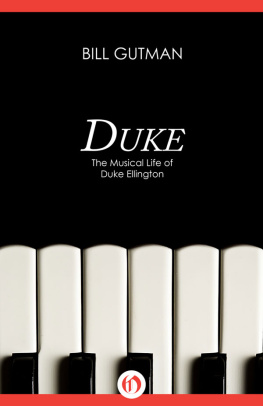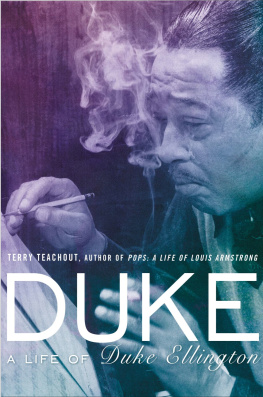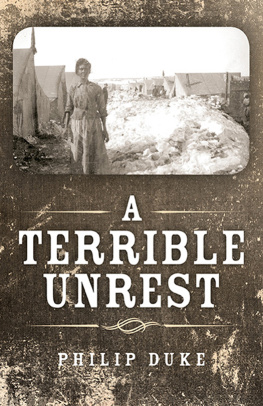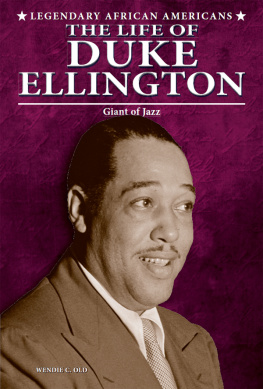Duke
The Musical Life of Duke Ellington
Bill Gutman

Acknowledgments
When writing about a man like Duke Ellington, it is difficult to cite all of those who have contributed to keeping his work, as well as his memory, alive. There are numerous persons connected both directly and indirectly with Duke and his world who have helped make this book possible. To begin with, there are the many, many musicianssome who gave themselves and their talents to Duke and others who gave to the jazz community at large. Then there are those behind the scenesfamily, friends, writers, critics, recording people, and fanswhose love and appreciation of Duke and his music have added to the ever-growing collection of Ellington memorabilia. And no list of acknowledgments would be complete without a full expression of indebtedness to the man himself, Edward Kennedy Ellington, for having lived, worked, and inspired so many people.
The author would also like to give very special thanks to the following men for personally sharing with him their recollections and feelings about Duke Ellington: Stanley Dance, Billy Taylor, Brooks Kerr, Russell Procope, and Pastor John Gensel.
Grateful acknowledgment is made for permission to reprint excerpts from the following works:
From MUSIC IS MY MISTRESS by Duke Ellington. Copyright 1973 by Duke Ellington, Inc. Reprinted by permission of Doubleday & Company, Inc.
From DUKE ELLINGTON by Barry Ulanov. 1946 by Barry Ulanov. Copyright renewed 1973 by Barry Ulanov. Reprinted with the permission of Farrar, Straus & Giroux, Inc.
From obituary article about Duke Ellington, May 25, 1974. 1974 by The New York Times Company. Reprinted by permission.
From "Ellington in Private" by Irving Townsend, The Atlantic Monthly, May, 1975. Reprinted by permission of Harold Ober Associates Incorporated. Copyright 1975 by Irving Townsend.
From "Farewell to the Duke" by Ralph Gleason. From Rolling Stone, 1974 by Rolling Stone Magazine. All rights reserved. Reprinted by permission.
From THE WORLD OF DUKE ELLINGTON by Stanley Dance, 1970 by Stanley Dance and THE WORLD OF SWING by Stanley Dance, 1974 by Stanley Dance. Reprinted by permission of Charles Scribner's Sons.
Other books containing information about Duke Ellington:
BIG BAND JAZZ by Albert McCarthy, G. P. Putnam's Sons, 1974.
EARLY JAZZ: ITS ROOTS AND MUSICAL DEVELOPMENT by Gunther Schuller, Oxford University Press, 1968.
Contents
Acknowledgments
1. The Duke
2. "Music for All Occasions"
3. The Birth of Jazz
4. The Washingtonians
5. The Cotton Club
6. On The Road
7. The Swing Era
8. Down Time
9. "Newport Up"
10. World Traveler
11. "Praise God and Dance"
12. The Private Man
13. Endings
Discography
The Duke
In April 1969 the President of the United States stood before a large gathering of more than a hundred people in the elegant ballroom of the White House. He raised his glass and told his audience that in the past he had toasted ambassadors, prime ministers, kings, and queens, but this was the first time he had ever toasted a duke. The duke accepted the toast graciously, bowing in the direction of his host. Then, smiling broadly, he kissed the surprised President twice on each cheek.
The duke was not a visiting dignitary from a foreign country. He was a black man born in Washington, D.C.Edward Kennedy "Duke" Ellington, one of the greatest figures in the history of American music. The gala White House party was being held in honor of his seventieth birthday. And that evening President Richard M. Nixon presented Duke Ellington with the Presidential Medal of Freedom, the highest award the United States government can bestow upon a civilian.
But the highlight of the evening was the music, mostly Duke Ellington's music, a music called jazz. Scores of prominent jazz musicians, along with many government officials, had been invited to the party. Most of them knew Duke, and all of them loved his music. Eagerly, the musicians took turns performing the music that Duke had been giving the world for some fifty years. And once they started they were hard to stop. Even after President and Mrs. Nixon had retired for the night, the formal White House ballroom rocked with the swinging rhythms of a jam sessionuntil the wee hours of the morning.
Duke himself spent a great deal of time at the piano that night, sometimes sharing the spotlight with other greats of the jazz world. For a while he sat next to his friend and teacher Willie "the Lion" Smith and cheered the older pianist on.
"The big moment for me," Duke said later, "was when I saw my man, the Lion, playing the President's grand piano with his derby on his head!"
How was it that this man, Duke Ellington, was chosen to be honored by the President of the United States and given his country's highest civilian award? Fifty years earlier the same Duke had been a clerk in a government office in Washington who spent his spare time organizing dance bands to make a little extra money for himself.
In those days a new music was just beginning to develop. It was a music that would eventually become known as jazz, but was then considered low and vulgar by most respectable people. It was a music that had grown directly out of the experience of black people in America, played and sung wherever black people lived and worked. And Duke Ellington, proud of his black heritage, loved that music. Perhaps no other musician was as important to its growth and development.
Duke became a prominent jazz pianist in his own right. But he was also one of the most important composers and arrangers to have worked in the idiom. For fifty years he managed to keep a large orchestra together through good and bad times, using the band as his mode of expression, an instrument to play his compositions. In doing so he helped create a whole new world of sound.
During Duke Ellington's long career, the new music slowly emerged from the saloons and cabarets, made its way into the dance palaces and night clubs, and eventually climbed onto the concert stage. Jazz had great popular appealto young and old, black and white, rich and poor alike. In time, jazz became universally recognized as a legitimate art form, and some contend it is the only art form to have originated on American soil.
Duke Ellington remained in the forefront of the new music for more than half a century. By the 1960s, Duke was an unofficial ambassador of the United States, traveling with his band to every corner of the world. On tours sponsored by the United States Department of State, they played in Russia, Japan, Latin America, the Far East, the Middle East, and Africa. Wherever they went, jazz was recognized not only as a form of black expression but also as a unique form of American expression.
Duke himself was a man of elegance and mystery. In the early days of jazz, when many whites looked down on the black man and his music, Duke Ellington brought grace and dignity to every performance. Jazz historian Leonard Feather once described Ellington the public figure: "An inch over six feet tall, sturdily built, he had an innate grandeur that would have enabled him to step with unquenched dignity out of a mud puddle. His phrasing of an announcement, the elegance of his diction, the supreme courtesy of his bow, whether to a duchess in London or a theater audience in Des Moines, lent stature not only to his own career, but to the whole world of jazz."
Duke's private life was not as easy to describe. He was something of an enigma. It is known that he spent much of his time writing and arranging music for his band. And although he had many friends, none of them ever came to know the whole man. He always kept a part of himself in the shadows, revealing only as much to a person as he desired. He could be friendly and personable, but he also jealously guarded his privacy, perhaps because he had so little of it.











